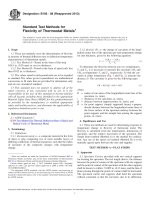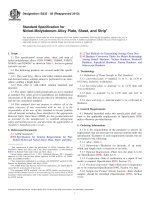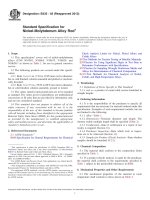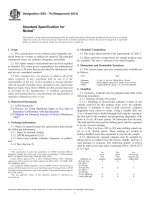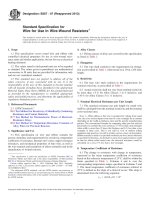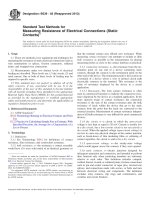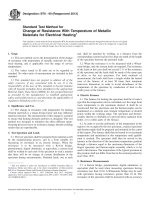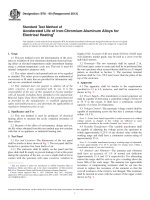Astm b 539 02 (2013)
Bạn đang xem bản rút gọn của tài liệu. Xem và tải ngay bản đầy đủ của tài liệu tại đây (113.35 KB, 7 trang )
Designation: B539 − 02 (Reapproved 2013)
Standard Test Methods for
Measuring Resistance of Electrical Connections (Static
Contacts)1
This standard is issued under the fixed designation B539; the number immediately following the designation indicates the year of
original adoption or, in the case of revision, the year of last revision. A number in parentheses indicates the year of last reapproval. A
superscript epsilon (´) indicates an editorial change since the last revision or reapproval.
that the nominal contact area offered zero resistance. When
measuring contact resistance one attempts to include as little
bulk resistance as possible in the measurement, by placing
measuring probes as close to the contact interface as practical.
1. Scope
1.1 These test methods cover equipment and techniques for
measuring the resistance of static electrical connections such as
wire terminations or splices, friction connectors, soldered
joints, and wrapped-wire connections.
3.1.3 connection resistance, n—the resistance from the termination point on one end of a device containing static
contacts, through the contacts to the termination point on the
other end of the device. The termination point is the location on
a terminal of a device where a wire or printed circuit path
electrically connects to the terminal. This resistance is the
value of resistance displayed by the device in a circuit
application.
3.1.3.1 Discussion—The term contact resistance is often
used in commercial literature to indicate the connection resistance displayed by the device in a standard application. In the
more rigorous usage of contact resistance, the connection
resistance is the sum of the contact resistance plus the bulk
resistance of leads within the device that go to the static
contacts from the point that the leads are connected to the
external circuitry. Measurement of contact resistance independent of all bulk resistance is very difficult for most commercial
devices.
1.2 Measurements under two distinct levels of electrical
loading are described. These levels are: (1) dry circuit, (2) and
rated current. One or both of these levels of loading may be
required in specific cases.
1.3 This standard does not purport to address all of the
safety concerns, if any, associated with its use. It is the
responsibility of the user of this standard to become familiar
with all hazards including those identified in the appropriate
Material Safety Data Sheet (MSDS) for this product/material
as provided by the manufacturer, to establish appropriate
safety and health practices, and determine the applicability of
regulatory limitations prior to use.
2. Referenced Documents
2.1 ASTM Standards:2
B542 Terminology Relating to Electrical Contacts and Their
Use
E122 Practice for Calculating Sample Size to Estimate, With
Specified Precision, the Average for a Characteristic of a
Lot or Process
3.1.4 dry circuit, n—a circuit in which the open-circuit
voltage is less than or equal to 20 mV. Current is usually low
in a dry circuit, but a low-current circuit is not necessarily a
dry circuit. When the applied voltage (open-circuit voltage) is
too low to cause any physical changes in the contact junction,
such as break-down of thin insulating films or softening of
contact asperities, the circuit is said to be a dry circuit.
3. Terminology
3.1 Definitions:
3.1.1 See Terminology B542 for definitions of contact
resistance, film resistance, and constriction resistance.
3.1.2 bulk resistance, n—the resistance a contact assembly
would have if it were solid metal of an identical geometry so
3.1.5 open-circuit voltage, n—the steady-state voltage
which would appear across the contacts if they were opened.
3.1.6 static contacts, n—electric junctions designed for
infrequent separation and connection, and intended to perform
their function only when contacting members are stationary
relative to each other. This definition includes crimped,
welded, brazed, riveted, or soldered joints; friction connections
such as pin and socket connectors or taper pins, twisted-wire
splices; and connections made with screws, or bolts and nuts
between electrical wiring and components. The definition
excludes relay contacts, slip rings and commutators, and
switches and circuit breakers.
1
These test methods are under the jurisdiction of ASTM Committee B02 on
Nonferrous Metals and Alloys and are the direct responsibility of Subcommittee
B02.11 on Electrical Contact Test Methods.
Current edition approved Aug. 1, 2013. Published August 2013. Originally
approved in 1970. Last previous edition approved in 2008 as B539 – 02 (2008).
DOI: 10.1520/B0539-02R13.
2
For referenced ASTM standards, visit the ASTM website, www.astm.org, or
contact ASTM Customer Service at For Annual Book of ASTM
Standards volume information, refer to the standard’s Document Summary page on
the ASTM website.
Copyright © ASTM International, 100 Barr Harbor Drive, PO Box C700, West Conshohocken, PA 19428-2959. United States
1
B539 − 02 (2013)
are electrically parallel. In practical cases the clean metal-tometal contact spots will carry most of the current and the total
contact resistance is primarily dependent on the size and
number of metallic contact spots present (see Note 1). In
addition, acceptably low values of contact resistance are often
obtained with true areas of contact being significantly less than
the apparent contact area. This is the result of having a large
number of small contact spots spread out over a relatively large
apparent contact area.
3.2 Descriptions of Terms for Levels of Electrical Loading:
3.2.1 dry circuit, n—This method provides for measurement
of contact resistance under very low levels of electrical
excitation, with applied voltages and currents selected to be too
low to cause breakdown of thin oxide films or other contaminates in the contact interface or to cause formation of metallic
bridges across the interface where none may otherwise exist.
Dry circuit testing is intended to determine whether the test
contact will function properly in circuits of arbitrarily low
levels of electrical excitation. Dry circuit testing procedures
should be used when the possibility of films or contaminants in
the contact interface exists or when the test sample is ultimately intended for use in a low-level circuit. This testing must
precede other tests on the same samples at high levels of
electrical loading.
3.2.2 rated current, n—The rated current for a static contact
device is determined or specified by the vendor or user of the
device. The rated current may be large enough to cause
significant heating of the test samples. When rated current
measurements of contact resistance are required, using either
ac or dc test currents, the procedures outlined for temperature
stabilization in 9.5.3 must be followed.
NOTE 1—The term metallic contact as used here is intended to include
the so called quasi-metallic contact spots as well. The latter case was
discussed in Electric Contacts by Holm. 3
5.2 The practical evaluation and comparison of electrical
connections depend in large part on their contact resistance
characteristics. On the one hand, the absolute value of contact
resistance is greatly dependent on the amount of metallic
contact established and indicates initially how efficient the
system is in producing areas of metallic contact. On the other
hand, a comparison of the initial resistance to the resistance
after aging indicates how stable the system is in maintaining
the initial contact area. Both of these characteristics should be
considered when evaluating contact systems. The criteria
employed in evaluating contact resistance and stability are not
a part of these test methods as they depend on specific
applications and therefore, will not be quantitatively stated.
However, an estimate of contact resistance3 resulting from
good metallic contact can be made for a given physical
situation and used as a comparison to actual measurements to
determine how effective the system is in establishing stable
metallic contact. Resistances measured by these methods
before, during and after simulated life tests are used as a means
of determining the stability of contacts within a device.
4. Summary of Test Methods
4.1 The test methods described herein are characterized as
four-terminal resistance measuring techniques, wherein a measured and controlled test current is introduced into the sample
using two“ terminals” or connecting points, and two other
points are selected on the sample across which a voltage drop
is measured. This voltage drop, divided by the test current, is
the effective overall resistance of the sample included between
the voltage probes. The voltage-measuring points are chosen so
as to measure as closely as possible the voltage drop due only
to the contact resistance of the sample and to eliminate from
the measurement as much as possible the resistance of the
metal pieces comprising the contact and the resistance of the
wires and connections used to introduce the test current into the
sample.
6. Interferences
6.1 Measurement of Low Resistance:
6.1.1 Contact resistances are normally very small, ranging
from microohms to a few milliohms in cases of practical
interest. The measurement of resistance in this range requires
special techniques to eliminate effects of thermal potentials,
external interference, and resistance of connections and wires
leading to the test sample.
6.1.2 The resistance-measuring procedures in these test
methods are four-terminal techniques. Test current in the
sample is measured and controlled, and made independent of
the sample resistance. Voltage-measuring probes are attached
to the sample so as to eliminate the effects of connections of the
sample into the test circuit. If the purpose of the measurement
is to determine the contact resistance, the voltage measuring
probes are attached as close as feasible to the static contacts, so
as to include as little of the bulk resistance of the sample as
possible in the measurement of the contact resistance.
6.1.3 Two wire measurements of resistance are not suitable
because connections to the sample will contribute part of the
measured resistance, and these may be large, unknown, and
variable.
4.2 Two different levels of test current are specified. The
choice of which level to use is governed by the application and
requirements of the electrical connection being tested. Electronic signal-circuit connections may require low-level (drycircuit) testing, whereas power-handling wire connectors
should be tested at rated current.
4.3 Either ac or dc test currents may be used, with appropriate instrumentation.
5. Significance and Use
5.1 As stated in Terminology B542, contact resistance is
comprised of a constriction resistance and a film resistance.
When present, the latter of these is usually much greater in
value and dominates the contact resistance. For a given contact
spot, when the film resistance is zero or negligible the contact
resistance for that spot is nearly the same as the constriction
resistance and therefore, as a practical matter, has a minimum
value which represents a clean metal-to-metal contact spot. As
real contact surfaces exhibit varying degrees of roughness, real
contacts are necessarily composed of many contact spots which
3
Calculations and formulae for contact resistance of various types of contacts are
covered very thoroughly in Holm’s Electric Contacts, 4th Edition, Springer-Verlag,
New York.
2
B539 − 02 (2013)
7.1.1 Power Supply—A supply capable of providing the
required current and, in the case of the dry circuit measurement
capable of limiting the current to 100 milliamps and the open
circuit voltage to 20mV. The supply may be dc or ac, but the
voltage measuring device must match the type of current from
the supply.
7.1.2 Voltmeters and ammeters built into power supplies
may or may not meet the requirements of these methods with
respect to accuracy or precision. External metering should be
used when necessary.
7.1.3 Both output terminals of the dc supply must be
isolated from the power line, the case of the supply, and the
building ground. This prevents “ground loops” or undesired
connections through ground, between the power supply and
other measuring instruments (such as an electronic voltmeter)
attached to the sample.
7.1.4 The maximum current required in the power supply
can be estimated from Table 1, which gives rated currents for
various wire-size terminations according to Military specifications.
7.1.5 The output current of the power supply should be
variable and readily and accurately adjustable.
6.1.4 Because the resistance being measured is often in the
microohm or milliohm range, and it is determined by measuring the potential across the static contacts, the value of the
potential is often in the microvolt or millivolt range. As a
result, thermal potentials may be significant in relation to the
potential being measured and appropriate measures are required to cancel or eliminate their effects.
6.1.5 In the dry circuit method, high potential may change a
resistance by breaking down a film. Appropriate caution is
required to obtain valid dry circuit resistance measurements
including limiting the open circuit voltage of the measuring
apparatus that is connected to the device under test.
6.2 ac Versus dc Measurements:
6.2.1 Either method described herein can be used with ac or
dc test currents, with appropriate changes in instrumentation to
correspond with the power supply. The methods are described
as using dc test currents, and the following comments apply
when ac is used.
6.2.2 ac measurements should be expressed as RMS unless
otherwise defined in the test report. Take appropriate measures
to isolate the measurements from stray signals, especially sixty
hertz power line noise. Commercial resistance measuring
instruments that use ac test currents generally are suitable
providing that they meet other requirements of the standard.
7.2 Current Measuring Device—a meter, ac or dc, to match
the power supply current type or suitable alternate measuring
circuitry is needed. The accuracy of the device must be 1 % or
better of the measured current. Some power supplies include
measurement capability of sufficient accuracy. An external
arrangement of a calibrated fixed resistor wired in series with
the test current and a voltmeter across the resistor is suitable
provided that it achieves the accuracy required.
7. Apparatus and Test Circuits
7.1 Fig. 1 shows the basic arrangement of a four wire circuit
for measuring. In the illustration, the measured resistance is the
resistance between the points where the voltmeter is attached to
the test specimen, that is, between the points of V1 and V2. The
measured resistance includes the contact resistance at the
contact between the two rounded points and the bulk resistance
out to the point where the voltage probes touch the test
specimen. To measure connection resistance, move the voltage
probes away from the contact point to the very end of each
contact member where the current leads are attached. To
attempt to measure contact resistance, move the voltage probes
as close as possible to the contact point. The equipment
consists of the following elements:
7.3 Reversing Switch—Since millivolt-drop readings across
the sample are to be taken with both forward and reverse dc
current, a double-pole-double-throw switch of suitable currenthandling capacity inserted in the current leads is used to
reverse the current in the test specimen. Alternatively, some
power supplies are programmable to reverse the current flow
direction and the current may be reversed with this feature in
the supply rather than with a separate switch.
FIG. 1 Schematic Representation of 4 Wire Measurement Circuit
3
B539 − 02 (2013)
TABLE 1 Test Current for Various Wire Sizes
(From Military Specifications MIL-T-7928 and MIL-T-7099)
A
Wire
Size
Amperes
Copper Wire
Amperes
Aluminum Wire
26
24
22
20
18
16
14
12
10
8
6
4
2
1/0
2/0
3/0
3/0
3
4.5
9
11
16
22
32
41
55
73
101
135
181
245
283
328
380
A
8.2 Assuming normal statistics apply, a suitable sample size
can be obtained from the following equation:
N5
A
where:
E/ X¯
3σx/ X¯
A
A
A
A
A
F G
3σx/ ¯
X
¯
E/X
2
(1)
= maximum allowed sampling error, %, and
= advance estimate of sample variation, % (σx =
standard deviation, X¯ = mean).
A
8.2.1 For example: assume for small wire terminations
(AWG 28 to AWG 20) where one inch of wire is included in the
measured resistance 3σx/X¯ = 15 % and for E/X¯ = 5 %, the
minimum value of N = 9 is obtained. If a sampling error of 3 %
were chosen, then the sample size becomes N = 25. It should be
noted that N is an estimate of the sample size required to
statistically establish the mean response of a specimen for a
prescribed sampling error and given sample variation. This test
method, however, requires that the underlying statistical distributions be normal. If significant deviations from normality
occur, then an analysis should be performed using more
suitable statistics.
8.2.1.1 There are many mathematical techniques to test for
normality but the easiest method is to plot the existing data on
normal probability paper. If the data appears to fall on a
straight line in such a plot, then one can assume that distribution is approximately normal and proceed accordingly. It
should be noted that a good rule of thumb is to use at least eight
plotted points to validate the graphical analysis. It is sometimes
found that the natural log of resistance is approximately
normally distributed. To test for the condition, the preceding
numerical and graphical analysis would apply to replacing the
resistance and standard deviation with the natural log of
resistance and standard deviation of the natural log of
resistance, respectively.
A
60
83
108
152
202
235
266
303
These values are not available.
7.4 Millivoltmeter:
7.4.1 A voltmeter with an accuracy of 1 % or better of the
measured voltage. Generally, an accuracy of 10 microvolts will
be adequate to meet this requirement and is readily available in
modern bench instruments.
7.5 Current and Voltage Probes:
7.5.1 Current is introduced to the device in a way to best
simulate how it flows when the device is in service. For
example, if the device is normally connected with soldered
wires, the same arrangement would be recommended as the
manner that its resistance would be measured.
7.5.2 Voltage probes must be placed or attached so as to
cause minimal change in the device or the current flow pattern
through it. In general, small probes are preferred. If attachment
by soldering or spot welding is selected, it should be performed
with caution to minimize possible heating or contamination of
the contact being measured.
7.5.3 In corrosion testing of stranded wire terminations the
stranded wires often become corroded under the insulation
covering for some distance along the wire. Subsequent resistance measurements are then difficult to make accurately
because of a loss of strand-to-strand conductivity and the
inability of a probe to contact all of the strands in the wire. A
procedure to eliminate this difficulty involves the inclusion of
a “potential-measuring point” on the wire in the form of a
current equalizer (soldered spot, welded spot, strandgathering
crimped sleeve) holding all of the strands together. The current
equalizer should be far enough away from the terminal (at least
2.5 cm) so that the operation of applying it cannot affect the
test joint. In the final result, the fact that a resistance equivalent
to the added length of wire is included in the measurement
should be considered.
9. Procedure
9.1 Preparation of Test Specimens—In general, test specimens should be prepared as nearly as possible as they would be
for normal application. Wire connectors, for example, should
be applied with the manufacturer’s recommended tooling on
correct wire sizes. Means must be provided for connection to
the test-current source, with lead lengths to the test specimens
long enough to isolate the test contact from the heat generated
in the power supply and its connections. Voltage-drop probing
points on the test specimens must be accessible, and the test
specimens must be supported so that probing will not mechanically disturb the test contact. When large numbers of similar
parts are to be tested, a test fixture is recommended. On some
test specimens it is possible and desirable to provide permanently attached voltage-measuring leads, but the attachment of
the leads must not impose abnormal or unrealistic conditions
on the test specimens. For instance, soldering voltage leads
close to the contact surface of a friction connection may
contaminate the contact surface or affect the temper of the
spring members. Unless one is deliberately testing for the
effects of contact motion on the contact resistance, it is
8. Sampling
8.1 The sampling plans described below are based on
statistical procedures presented in Practice E122.
4
B539 − 02 (2013)
9.5.4 Measure the resistance using a suitable dc or ac
method. The dc method with current reversal given in 9.3 is
suitable, however, current reversal may be unnecessary if the
voltage drop is large compared with thermal potentials.
important to avoid any mechanical motion or stress on the test
specimens throughout the preparation, measurement, or conditioning steps.
9.2 Pretreatment, aging, or environmental conditioning of
the test specimens is not a part of these test methods.
Temperature stabilization of the test specimen, either at the
ambient temperature or at rated-current operating temperature,
is important, however, and should be assured as outlined in
9.5.3.
9.6 Test Method C, Dry Circuit Testing:
9.6.1 The primary requirement for dry circuit testing of
contacts is that the voltage and current applied to the test
specimens must never be allowed to exceed certain maximum
limits. These limits are: 20 mV (0.020 V) and 100 mA (0.100
A). To assure these limits, use a power supply circuit that
provides 20-mV open-circuit voltage and 100-mA short-circuit
current.
9.6.2 Maintain the above maximum limits on test voltage
and current. Avoid transient voltage pulses due to switching a
power supply on or off, since it is known that pulses as short as
0.1 µs can cause oxide film breakdown and thereby invalidate
a dry circuit test. An output resistance for the power supply of
0.2 Ω is implied by these specifications. Avoid the use of a
supply with higher than 0.2 Ω to obtain a test current of 100
mA, since a momentary loss of contact in a test specimen
would apply a voltage greater than 20 mV to the test specimen.4
9.6.3 In dc dry circuit testing of contacts, thermal potentials
must be eliminated as thoroughly as possible in the test
specimen and its connecting leads to the power supply. The
most general method of eliminating the effects of thermal
potentials is to make forward-and-reverse-current readings and
calculating resistance as given in 9.3. An alternate dc method
uses a pulsed current where potential is measured first with an
applied current and second with no current applied. The
resistance is then calculated as:
9.3 General Procedure for dc Measurement with Current
Reversal:
9.3.1 With the current off, connect the test specimen into the
test circuit.
9.3.2 Switch on the power supply, and increase the test
current to the desired value (see 9.5 and 9.6).
9.3.3 When testing at rated current the temperature shall
stabilize such that the increase in the temperature of the test
specimen is <2°C per hour.
9.3.4 Connect the voltmeter probes to the test specimen, and
read the contact voltage drop. Check that the current through
the test specimen is at the correct value.
9.3.5 Reverse the direction of the current through the test
specimen.
9.3.6 Read the reverse-voltage drop.
9.3.7 Calculate the resistance as follows:
? ? ? ?? ? ? ?
R 5 Ef 1 Er / If 1 Ir
(2)
where:
R = resistance,Ω ,
Ef = forward voltage drop, V,
Er = reverse voltage drop, V,
If = forward current, A, and
Ir = reverse current, A.
R5
9.3.8 This procedure eliminates the effects of thermal potentials from the measurement and compensates for lack of
precision in zeroing the test instruments.
~ E1 2 E0 !
I
(3)
where:
E1 = potential with current I applied, and
E0 = potential with no current applied.
This alternate method is automatically used in some commercial instruments.
9.6.4 The use of ac in dry circuit testing eliminates problems
due to thermal potentials in the test circuit and test specimen.
These test methods encourage the use of ac when suitable
instrumentation is available. Certain commercial LCR measurement instruments use an ac measurement current and can
be programmed to meet the current and voltage requirements
for dry circuit testing. Users of ac methods are cautioned that
the peak to peak current and voltage must conform to the
requirements of 9.6.1.
9.6.5 These test methods encourage the use of commercial
test sets for dry circuit testing, provided the instrument is
known to meet the voltage and current limitations of 9.6.1.
9.6.6 Dry circuit testing procedure is as given in 9.3, with
precaution that dry circuit testing should precede any other
electrical tests on the test specimen.
9.4 Test Method A, Standard Test Current—Discontinued as
a test method.
9.5 Test Method B, Rated Current Testing:
9.5.1 Table 1 is an example of currents used in rated current
tests of static contacts and connectors. Rated currents are
specified by vendor or user and are generally large enough to
heat the test samples. Consequently, measured resistances may
be different from those obtained with Test Method C.
9.5.2 Report in detail the conditions under which rated
current measurements are made. The size of the parts, lead
lengths, mounting provisions, ambient temperature, and ventilation of the test position will affect the temperature at which
the test specimens stabilize, as well as the time required to
reach a stable temperature.
9.5.3 Read the resistances when the temperature of the test
specimen has stabilized with current flowing. Determine the
time for stabilization by taking a series of readings of resistance or temperature as the test specimen warms. When the
temperature stabilizes the readings will become constant.
Record the time required, and allow this time before each
measurement on similar test specimens.
4
Schubert, R., “Sealing Current and Regeneration of Copper Junctions,” IEEE
Trans. Comp., Hybrids, and Manu. Tech., Vol 14, No. 1, 214 (1991).
5
B539 − 02 (2013)
10. Report
11.1.1 It should be noted that in this equation the factors of
one half are derived from the fact that forward and reverse
measurements were used to calculate the resistance. In the case
of a single measurement with alternating current, the factor
should be one rather than one half. In addition, this equation
does not account for errors due to thermal effects and zero drift
which may occur between the forward and reverse readings,
nor does it account for any bias which produce additive or scale
errors. As an alternative, the system bias can be determined by
making successive readings of a resistance standard which is
comparable to the level of resistance the test samples exhibit.
These readings can be applied using standard statistical analysis to estimate the system accuracy. A minimum of 20 readings
should be used to provide sufficient statistics. A standard
precision resistor with a bias of 0.1 % or better is recommended in this procedure. As an example, a 0.01 Ω resistance
standard with a 0.1 % accuracy is commercially available.
Resistance standards below the 0.01 Ω level are also commercially available, but these standards are generally NIST types
and may not be practical to obtain. The choice of procedure
used to estimate the system bias shall be described in the
report.
10.1 Report the following information:
10.1.1 Test method used, B, or C,
10.1.2 DC current readings, forward, reverse, and average,
NOTE 2—For ac measurements, indicate whether readings are average,
peak, or rms sine wave.
10.1.3 Calculated resistance shall be tabulated. It is recommended that medians, or means and standard deviations of
resistance and probability plots of resistance or resistance
change be included where appropriate.
10.1.4 Description of test specimens (types, material, finish,
etc.),
10.1.5 Wire and contact size, where applicable,
10.1.6 Conditions of test (temperature, humidity, etc.),
10.1.7 Sample preparation (tooling, method of application,
etc.),
10.1.8 Instruments used, model, type, and accuracy,
10.1.9 Probe spacing or position, or both, of voltagemeasuring probes on samples,
10.1.10 Time required for temperature stabilization, when
Method B is used,
10.1.11 Readings on equivalent length of wire not including
a splice or termination, or readings obtained with a standard
resistance test sample, where applicable, and
10.1.12 Identification of whether reported values are contact
resistance or contact resistance plus bulk resistance.
11.2 Precision—Repeatability of duplicated readings by a
single operator shall be within =2 εR and reproducibility of
mean results of unaged samples for similar specimens measured by different operators using different equipment should
be within the following estimated percentage:
11. Precision and Bias
ε c 5 =ε 2 s 1 1ε 2 s 2
11.1 Bias—As indicated in Section 7, the ammeters and
voltmeters employed in this procedure shall each have accuracies of 1 % or better. Since, in general, the accuracy
associated with the voltage drop measurements is dependent on
the levels of resistance being measured and the test methods in
accordance with this standard, such accuracy shall be stated in
the report. To determine the system accuracy, an error propagation analysis can be performed by assuming the source of
error as a normal random variable. The following equation can
then be used to estimate the system accuracy:
εR 5
Œ
1 2 1
ε 1 ε
2 v 2
(4)
where:
εc = maximum allowable difference, %,
εs1 = sampling errors from Laboratory 1, and
εs2 = sampling errors from Laboratory 2.
11.2.1 It should be noted that the comparison of mean
results have been based on a sample size as determined in
Section 8 on sampling where an advance estimate of three
times the standard deviation was used. Therefore, to make an
accurate statistical statement about reproducibility which also
includes a confidence limit, one must apply standard statistical
techniques that utilize both the sample size and standard
deviation.
2
I
where:
εR = error of the resistance reading, %,
εv = error to make each voltage drop reading, %, and
εI = error to make each current reading, %.
12. Keywords
12.1 connection resistance; connectors; contact resistance;
contacts; electrical resistance; junction resistance; low level
contact resistance; separable connections
NOTE 3—It is assumed that the instrument error for the forward and
reverse current readings is the same.
6
B539 − 02 (2013)
ASTM International takes no position respecting the validity of any patent rights asserted in connection with any item mentioned
in this standard. Users of this standard are expressly advised that determination of the validity of any such patent rights, and the risk
of infringement of such rights, are entirely their own responsibility.
This standard is subject to revision at any time by the responsible technical committee and must be reviewed every five years and
if not revised, either reapproved or withdrawn. Your comments are invited either for revision of this standard or for additional standards
and should be addressed to ASTM International Headquarters. Your comments will receive careful consideration at a meeting of the
responsible technical committee, which you may attend. If you feel that your comments have not received a fair hearing you should
make your views known to the ASTM Committee on Standards, at the address shown below.
This standard is copyrighted by ASTM International, 100 Barr Harbor Drive, PO Box C700, West Conshohocken, PA 19428-2959,
United States. Individual reprints (single or multiple copies) of this standard may be obtained by contacting ASTM at the above
address or at 610-832-9585 (phone), 610-832-9555 (fax), or (e-mail); or through the ASTM website
(www.astm.org). Permission rights to photocopy the standard may also be secured from the Copyright Clearance Center, 222
Rosewood Drive, Danvers, MA 01923, Tel: (978) 646-2600; />
7
